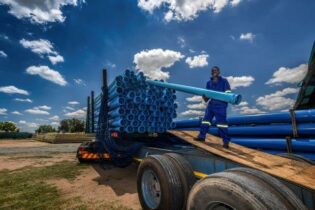The Department of Water Affairs is the custodian of South Africa’s water resources. It is primarily responsible for the formulation and implementation of policy governing this sector. It also has override responsibility for water services provided by local government.
While striving to ensure that all South Africans gain access to clean water and safe sanitation, the water sector also promotes effective and efficient water resources management to ensure sustainable economic and social development. National Water PolicyThere are three fundamental objectives for managing South Africa’s water resources, which are firmly grounded in the provisions of the Bill of Rights in the Constitution of South Africa (Act No 108 of 1996) and arise from the Principles. These are: – To achieve equitable access to water; that is, equity of access to water services, to the use of water resources and to the benefits from the use of water resources. – To achieve sustainable use of water by making progressive adjustments to water use with the objective of striking a balance between water availability and legitimate water requirements, and by implementing measures to protect water resources. – To achieve efficient and effective water use for optimum social and economic benefit.
Planning for the future requires a total paradigm shift to ensure optimal use of water. We need to ‘stretch’ our water, be it through water conservation, water reuse or desalination. However, when it comes to planning, there are many uncertainties. The fact that rainfall patterns in this country are very variable, population and economic growth cannot be reliably predicted and climate change effects differ from region to region across the country compounds the problem. South Africa prides itself in its ingenuity when it comes to availing water to areas of dire need, such as mines, agriculture, inter-basin transfer and building of dams. It won’t be long before the dam building option is economically viable. The Vaal River system is a case in point.
2004 National Water Resource Strategy
The 2004 National Water Resource Strategy is the document that governs how water systems should be managed.
The National Water Resource Strategy must, subject to item (4)(a) of Section 5:
(a) set out the strategies, objectives, plans, guidelines and procedures of the minister and institutional arrangements relating to the protection, use, development, conservation, management and control of water resources within the framework of existing relevant government policy in order to achieve –
(i) the purpose of this Act; and
(ii) any compulsory national standards prescribed under Section 9(1) of the Water Services Act, 1997 (Act No 108 of 1997). According to Johan van Rooyen, the Department of Water Affairs national water resource planning director, the National Water Resource Strategy is something citizens should take more seriously. “People should actually measure the department or the whole water sector against what we are saying in the strategy. This is something that should be used as a benchmark.” The main message is that fresh water is limited and availability varies from area to area. The document also lays out the list of all the options available to the department to reconcile the resource with demand. Overall and on average, there is more water than what is required. How does this work? The first part of the answer lies in the ecological reserve, which was introduced through the National Water Act of 1998.
National Water Act
The purpose of this Act is to ensure that the nation’s water resources are protected, used, developed, conserved, managed and controlled in ways which take into account, among other factors:
(a) meeting the basic human needs of present and future generations
(b) promoting equitable access to water
(c) redressing the results of past racial and gender discrimination
(d) promoting the efficient, sustainable and beneficial use of water in the public interest
(e) facilitating social and economic development
(f) providing for growing demand for water use
(g) protecting aquatic and associated ecosystems and their biological diversity
(h) reducing and preventing pollution and degradation of water resources
(i) meeting international obligations
(j) promoting dam safety
(k) managing floods and droughts.
Principle 1
The water law shall be subject to and consistent with the Constitution in all matters, including the determination of the public interest and the rights and obligations of all parties, public and private, with regards to water. While taking cognisance of existing uses, the water law will actively promote the values enshrined in the Bill of Rights. Principle 2
All water, wherever it occurs in the water cycle, is a resource common to all, the use of which shall be subject to national control. All water shall have a consistent status in law, irrespective of where it occurs. Principle 3
There shall be no ownership of water but only a right (for environmental and basic human needs) or an authorisation for its use. Any authorisation to use water in terms of the water law shall not be in perpetuity. Principle 4
The location of the water resource in relation to land shall not in itself confer preferential rights to usage. The riparian principle shall not apply.
Source: Fundamental principles and objectives for a new water law for South Africa






